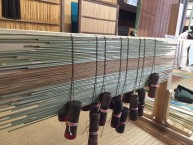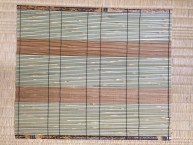This semester for my Community Involvement Project, I have been working with the Kubotas, a family of Kyoto artisans who make sudare screens for private homes and temples. Once a week, I go to their shop near Shijo, where I learn about the craft of sudare making and, through conversations with the artisans themselves, about life as an artisan in one of the most historical cities in the world.
One of the things that has stood out most clearly to me through working with the Kubotas is how closely their line of work connects them with traditional culture of Japan. In a country as modernized as Japan, it can be difficult sometimes to find traces of the culture’s long and rich history. When I’ve asked Japanese friends about their exposure to some of the most known traditional elements of Japanese culture—the kinds of traditional elements like shodo calligraphy and sado tea ceremony that are often presented to foreigners during cultural exchange events—their responses are largely of non-interest. For the artisans of Kyoto, however, this is not the case. The very nature of their work forces them to confront the divide between traditional and modern lifestyles in Japan on a daily basis. And as a result of this, they often find themselves exploring other aspects of traditional culture, aspects that have no connection to their particular craft.
Through working with the Kubotas on my own sudare, through talking with them as I bound the bamboo together strip-by-strip with twisting threads, I found that our conversations often tended to drift to this topic. Over a cup of matcha tea one week, we wound up talking about the tradition of the tea ceremony, something that I had been asked to participate in for cultural exchange events many times but still knew next to nothing about. When I mentioned this, Shinji Kubota, the oldest son and next in line to inherit the family business, began to tell me about how working as an artisan had inspired him to study tea ceremony. Although most Japanese had very little interest in the ceremony, had never even experienced one themselves, he found the ceremony beautiful and has been studying it for many years. Mayu, Shinji’s younger sister, also mentioned how central their background as traditional artisans was in sparking their shared interest in the ceremony.
When I came in the next week, I found the tatami room cleared and prepared for a tea ceremony. A piece of calligraphy hung in the tokonoma, beneath which sat a flower arrangement. Water boiled away in a kettle over the fire of the sunken ro hearth. Shinji and Mayu took me through the ceremony, explaining how every proper tea ceremony had a theme, which the host decided upon and would then carefully select each utensil to match. Through inquiring about the particular calligraphy piece hanging in the tokonoma, for example, you would be able to work your way through the various connections it shared with the other utensils of the ceremony. This ability to appreciate details is one of the most important elements of the ceremony.
The care with which Shinji and Mayu then walked me through the ceremony was truly amazing. It was clear how much they respected the ceremony’s tradition, how much they wanted to do justice to its history. Which of course connects to the way they treated their own craft as well. Throughout this whole semester, I have noticed lots of very tiny ways in which the Kubotas honor the history and tradition of their craft. They explained to me, for example, how the natural darkening of bamboo material over time is something beautiful, something worth noticing and appreciating. Which I don’t think is something I would have thought about in that way before.
My time with the Kubotas this semester has broadened my understanding of traditional Japanese culture as it exists in the modern age. Through making my own sudare, I have come to appreciate the incredible level of craftsmanship that goes into the making and maintaining of these traditional crafts. And through exploring the connections that exist between those who are continuing Japan’s craft tradition and those who are carrying on other aspects of the traditional culture, I have come to see the degree to which these traditions are still very much alive, still being constantly innovated.



It’s incredibly cool that you decided to do your CIP with some of the first artisans that we visited for Bethe-sensei’s class! Back in September, what was it that stuck out and made you decide to work with them? Learning chadō in an intimate setting also sounds like a great bonus. Best of luck getting your independent study approved with them, if you haven’t yet!
Thanks, Alan!
I had heard from Monica and Douglas that the Kubotas had a history of working with foreign students and would potentially be willing to do so again. Because I was so interested in how artisans live and work today, the small, family-business environment struck me as ideal. I had the opportunity to get to know them very well, which was exactly what I was hoping I would be able to do with my CIP.
It sounds like this CIP was a good experience for you! That’s quite a winsome sudare you made! Are you planning on continuing to work on making them after the program ends or were you just interested in giving it a try?
Thanks Corinne! I had a lot of fun making the sudare!
If possible, I would love to continue working with the Kubotas next semester, but I also don’t want to be a great big foreigner 迷惑. I am so grateful for everything the Kubota family has done for me this semester, so even if I can’t continue to work with them, I still feel that this experience has been incredibly worthwhile!
I’m impressed that you took the one-time opportunity of the field trip and turn it to a semester-long experience! Do you think there was any difference in the way they instructed the craft to you as opposed to, say, a full on disciple?
Thanks Hai-Anh!
From what I understand, sudare making today is actually partially mechanized. The Kubotas, however, decided to teach me the traditional, completely machine-free method of sudare making instead. I don’t know if the family would ever take on a full-time apprentice given how much of a family business it is, but I would imagine that that apprentice would be taught the more mechanized style of sudare making. The apprentice would also probably have their keigo-usage more strictly enforced as well. 😉
As the others have said, that sounds like an awesome CIP. Out of curiosity, were you interested in sudare in particular, or were you looking for some sort of traditional craft and sudare was what ended up working out?
Thanks Darbus!
My main motivation for pursuing this kind of CIP was to learn more about life as an artisan in Kyoto. It’s something that I’m incredibly fascinated by, and I knew that I wanted to pursue that interest outside of just our Kyoto Artisans class. I also really enjoy hands-on crafting of any sort. When I asked Monica and Douglas about potential sites, they told me that the Kubota family might be willing to take on a foreign student, so I decided to pursue working with them.
Nicolle, like I’ve been saying all semester, your CIP sounds absolutely fascinating. Aside from making the sudare screen (which looks great, by the way!), it’s incredible how you got to participate in things like the tea ceremony (and the incense ceremony?).
I think you were one of the few people who went for something distinctly non-traditional when it came to choosing a CIP. Did you have any issues when you first went up to the Kubotas? And what advice would you have for other people looking to try something different than the usual CIP activities?
Thank you Deb!
Working with the Kubotas has indeed been such a fulfilling part of life in Kyoto, and I am so grateful to them! I was terrified when Douglas and I asked them if they would allow me to work with them, but they responded so warmly that my anxieties quickly disappeared. I would say that my main advise for finding these kinds of unusual CIPs would be just to start asking around. It can be hard to find a CIP when the options are so wide and unspecified, but there are so many interesting connections that can be found through the people who work at KCJS, and they are all very willing to help out.